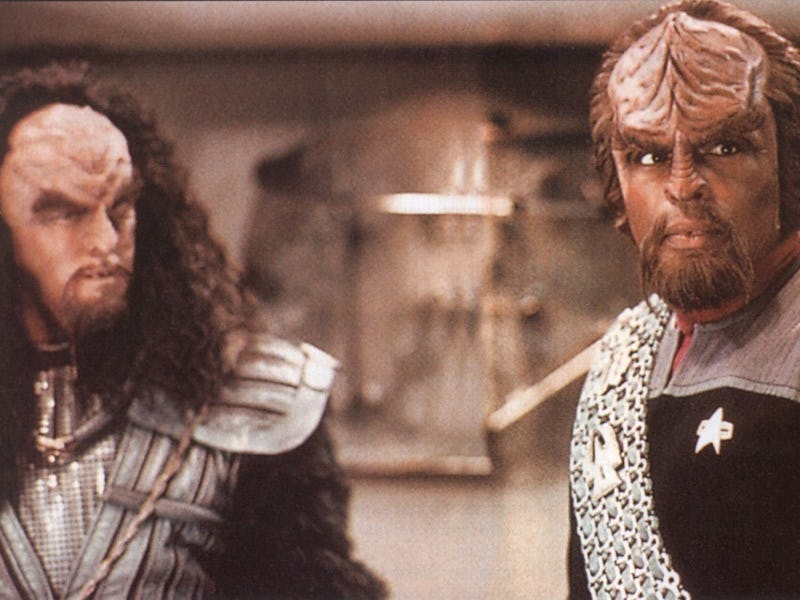The 5 Greatest Fictional Alien Languages
Fictional alien languages are a part of the rich tradition of science fiction world building.

Fictional alien languages — like the one prominently featured in Arrival — are a big part of science fiction world-building. One of the staples of creating a believable fictional world that’s different from our own is the careful consideration of what beings from other planets sound like and how they communicate.
The alien language of Arrival is a central part of the film, as is Dr. Louise Banks’s (Amy Adams) attempt at decoding it. Unique in that it makes communication and language the focal point of the film, Arrival is nevertheless part of a rich tradition of well-developed fictional alien languages. While some science fiction films and television shows may pass off scrambled words and assorted sounds as alien languages that are “believable enough,” some have created entire language systems to build out their fictional worlds. From Klingon to Kryptonian and from Mandalorian to Na’vi, the approaches to creating a language are radically different, but they all contribute to making their respective fictional worlds feel more real.
Here are five of the most popluar fictional alien languages of all time.
Klingon
There’s perhaps no fictional language more famous than Star Trek’s Klingon. The language was first spoken in Star Trek: The Motion Picture in 1979, but it wasn’t a real language with any structure until 1984’s Star Trek III: The Search for Spock. Marc Okrand created the language system, complete with grammar rules and a few quirks that you might expect from any language. For example, there’s no proper word for “hello” in Klingon, and there are only three directions, roughly translating to “area eastward,” “area northwestward,” and “area southwestward.”
There's a hoopy frood who really knows where his towel is.
Alienese
Originating from Futurama, Alienese often took on something of an Easter Egg role in the show. The symbol-based language showed up from time to time and, if one was to bother translating it, it often included pithy messages. Software Engineer Damian Reichel created a handy Alienese decoder, so if you’re watching Futurama and feel the urge to translate, this tool makes it easy.
Kryptonian
The language of Krypton, known as Kryptonian, isnt a full language system like Klingon, but its symbol-based system can be translated to the language of the publication. Since Superman and Supergirl are the only people who could read this language, the usefulness of that seems dubious. There’s a full alphanumerical key that makes translation easy, if a little time-consuming. Kryptonian is unique in that the written language has appeared in comic books, as well as Man of Steel and, most recently, Supergirl.
Mando’a / Mandalorian
The language of the people of the planet Mandalore in Star Wars is called Mando’a, and its written form is known as Mandalorian. The language is a collaborative effort, originating first in a written form which could be translated on a letter-by-letter basis. Philip Metschan created the written language for scenes in Jango Fett’s ship in Attack of the Clones. Later, Jesse Harlin created a spoken version of the language for lyrics used in the game Republic Commando.
The Star Wars galaxy is also pervaded by the fictional language Aurebesh. Like Mandalorian, Aurebesh was first created for a Star Wars film. It first appeared in Star Wars Episode VI: Return of the Jedi, but was further developed by Stephen Crane for use in Star Wars games from West End Games. Crane developed a 34-character alphabet with symbols that corresponded to one or, in some cases, two letters, along with symbols for numbers and punctuation marks.
Na’vi
The Na’vi language in Avatar (also called Na’vi) is a complete system, complete with its own vocabulary, grammar and syntax. It was created by Dr. Paul Frommer for the film, and there are resources for learning the language. Unlike some of the other fictional languages we see in science fiction, Na’vi uses an alphabet we’re largely familiar with, even the word constructions (and use of special characters) are new. Learning something like Mandalorian or Kryptonian might prove pretty difficult, but Na’vi would likely prove among the easier fictional languages to learn for anyone so inclined.
Arrival is in theaters now.